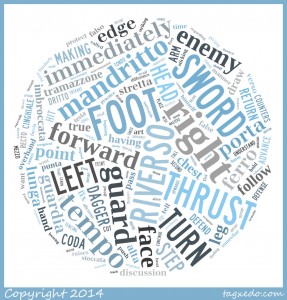Giovanni Dall’Agocchie’s Dell’Arte di Scrimia describes a short and lovely solo form when concluding the section on guards. In the marginalia he names this “Stepping in the guards: how it is done”.
My first brush with Dall’Agocchie came through this solo form. Years ago I was working through the Order of the Seven Hearts ‘Bolognese Introduction‘. This document included the solo form, so I went through it a few times, had it figured out, then moved on.
But I kept coming back to it. The more I learned about swordsmanship – reading original treatises and modern interpretations, taking classical fencing lessons, practicing on my own, studying Destreza, what-have-you – the more I realized that I hadn’t ever gone through Dall’Agocchie’s solo form quite right. There was always some new angle I could apply to it. I now understand that I will work on this for the rest of my life, and will always find something to improve.
I have a series of posts coming about this deceptively simple form. But before I say anything else, let’s end this introductory post with the master’s own words. (This starts on 11recto – page 12 of William Jherek Swanger’s translation):
{Stepping in the guards: how it is done.}
Gio. One steps with reason and art, and goes in all the guards to find the adversary. This can be done by beginning with either foot, on the diagonal or having one foot drive the other forward, according to the time and the need. Nonetheless, stepping with a pace neither large nor small is of greater utility, because thereby you can both advance forward and retire back without bodily discomfort, always accompanying the hand with the foot.
But you must be advised that the forward leg must be a bit bent at the knee, and its foot must point straight toward the enemy; and the rear leg will be a bit curved and with its foot somewhat on the diagonal, in such a manner that every movement will be full of grace. And so much for the fourth heading.
Lep. I would dearly appreciate it if you were to present to me better the way that one must follow in stepping in the said guards with the sword in hand, which I haven’t heard enough of.
Gio. Suppose you have your sword at your left side, in the act of laying hand upon it, and the heel of your right foot near your left one. Both your knees will be straight and not bowed, arranging yourself with as much grace as possible. Having done this, you’ll put your right foot forward toward your right side, and in that tempo you’ll extend your arm and do a falso, and a riverso sgualimbro; or do two riversi, the first tondo and the second likewise sgualimbro; thereby going with your sword into coda lunga stretta. And from here you’ll step forward with your left foot toward your left side, doing a falso and mandritto sgualimbro in that instant, and the sword will fall into cinghiale porta di ferro. And then you’ll go forward one pace with your right foot, and in that tempo you’ll turn a dritto tramazzone, which will end in porta di ferro stretta. Then you’ll advance with your left foot, doing a falso, and a riverso sgualimbro, and the sword will go into coda lunga alta. Then you’ll step forward with your right foot and in the same tempo you’ll throw a riverso ridoppio, stopping the sword in guardia d’alicorno. And being fixed in the said guard you’ll drive an imbroccata without any taking any step, and the sword will stop in porta di ferro stretta.
From here you’ll withdraw your right foot a pace, and all in one tempo you’ll execute a falso and a riverso sgualimbro, and the sword will return to coda lunga alta. Then you’ll draw your left foot back, and next turn a mandritto tramazzone, which will end in porta di ferro stretta. Then you’ll return your right foot back a pace, turning a dritto tramazzone in that tempo, with which you’ll fall [12recto] into cinghiale porta di ferro. And from here, you’ll draw the left foot back, doing a falso and riverso sgualimbro in that instant, and the sword will return to coda lunga stretta, and thus you’ll be returned to the same place with the same guards.
Lep. Why do you want me to step forward, and then return backwards?
Gio. Because you get good practice in changing guards as much forward as back, which is necessary in the art, and of very great utility; and so that you understand, this stepping is one of the chief things that you must practice if you want to have grace with weapons in hand.
